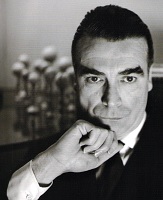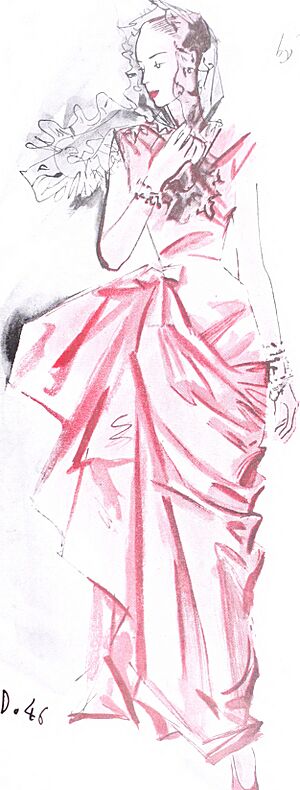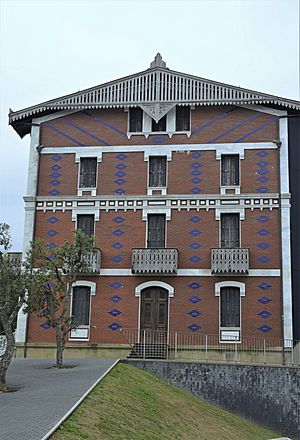Cristóbal Balenciaga facts for kids
Quick facts for kids
Cristóbal Balenciaga
|
|
|---|---|

Balenciaga in 1950
|
|
| Born |
Cristóbal Balenciaga Eizaguirre
21 January 1895 |
| Died | 23 March 1972 (aged 77) |
| Resting place | Getaria Cemetery |
| Other names | Basque: Cristobal Balentziaga Eizagirre |
|
Label(s)
|
Balenciaga |
Cristóbal Balenciaga Eizaguirre was a famous Spanish fashion designer. He started the well-known Balenciaga clothing brand. Other famous designers like Christian Dior called him "the master of us all." Coco Chanel said he was "the only couturier in the truest sense of the word." This shows how much he was respected in the fashion world. When he passed away in 1972, a fashion newspaper called him "The King."
Since 2011, you can visit the Balenciaga Museum in his hometown of Getaria. It shows many of his amazing designs. Over 1,200 pieces are in the collection. Some were given by his student Hubert de Givenchy and famous clients like Grace Kelly.
Contents
Early Life and Career
Cristóbal Balenciaga was born in Getaria, Spain, on January 21, 1895. His father was a fisherman who died when Cristóbal was young. His mother worked as a seamstress, making clothes. Cristóbal often watched his mother work and learned from her.
When he was just twelve, he started working as a tailor's helper. As a teenager, a very important woman in his town, the Marchioness de Casa Torres, became his customer. She helped him go to Madrid to get formal training in tailoring. Balenciaga was special because he could do everything himself. He could design, make patterns, cut fabric, and sew his own creations. This was rare for a fashion designer.
Becoming a Fashion King
Balenciaga became very successful in Spain. He opened his first shop in San Sebastián in 1919. Later, he opened more shops in Madrid and Barcelona. The Spanish royal family and rich people wore his clothes.
But the Spanish Civil War forced him to close his shops. So, Balenciaga moved to Paris, France, in 1937. He opened his fashion house there. After World War II, his unique designs really stood out. In 1951, he completely changed how women's clothes looked. He made shoulders wider and removed the tight waistline.
He designed the tunic dress in 1955. This later became the chemise dress in 1957. In 1959, he created the Empire line, which had high-waisted dresses and coats. These coats were cut like a kimono.
In 1960, he designed the wedding dress for Fabiola de Mora y Aragón. She married King Baudouin I of Belgium. The Queen later gave her wedding dress to the Cristóbal Balenciaga Foundation. Balenciaga taught fashion design classes. He inspired many other designers, including Oscar de la Renta and Hubert de Givenchy. His designs were often simple but looked like sculptures. They were seen as masterpieces of haute couture (high fashion) in the 1950s and 1960s.
Balenciaga's Unique Style
During the 1950s, many famous designers like Christian Dior and Coco Chanel were creating new styles. But Cristóbal Balenciaga was known as "The King of Fashion" because of his special way of designing. He was a master at tailoring, which means he was very skilled at cutting and sewing fabric. He could easily turn his ideas from paper into real clothes.
His amazing tailoring skills gave him an edge over other designers. People would travel from all over the world to buy his outfits. He changed how women's clothes looked in the 1950s. For example, while Christian Dior's "New Look" had full skirts and tiny waists, Balenciaga created more flowing, voluminous shapes. These included his one-seam Yoki coat and other large, comfortable designs.
Later Life and Legacy
Balenciaga closed his fashion house in 1968 when he was 74 years old. He had worked in Paris for 30 years. He decided to retire and closed his shops in Paris, Barcelona, and Madrid. He said that "High fashion is mortally wounded," meaning it was becoming too difficult to continue. High taxes in France and less business from American customers were some reasons.
Balenciaga returned to Spain. He spent his last years enjoying painting and spending time with friends. Four years after retiring, he made one last dress. It was a wedding gown for Carmen Martínez-Bordiú in 1972. This was his final design.
Balenciaga passed away on March 23, 1972, in Spain, at 77 years old. He was buried in his hometown of Getaria.
Even though Cristóbal Balenciaga closed his business, the "Balenciaga brand" continued. In 1986, a company bought the brand. Today, Balenciaga is still a very important name in fashion. People admire his sense of proportion and how he saw the female body. This has made him one of the most influential designers ever.
The Balenciaga brand now sells high fashion, ready-to-wear clothes, perfumes, jewelry, and other accessories. Their bags and shoes are especially popular. In museums, you can see his hats and headwear, which are known for their unique shapes.
Many famous designers learned from Cristóbal Balenciaga. These include Paco Rabanne, André Courrèges, and Hubert de Givenchy.
His work has been shown in many museum exhibits. In 1973, the Metropolitan Museum of Art in New York held a big show called "The World of Balenciaga." It displayed 180 of his designs. This was important because it was one of the first times a major art museum treated dresses as works of art.
In his hometown, the Balenciaga Museum finally opened in Getaria on June 10, 2011. It has 1,200 pieces, displayed on special invisible mannequins. His friend, the sculptor Eduardo Chillida, even made a sculpture called "Homage to Balenciaga." The city of San Sebastián also has a promenade named after him.
Balenciaga in Museums
The Balenciaga Museum in Getaria has a collection of 1,200 pieces. The Museum of Textile and Clothing in Barcelona also has many Balenciaga dresses and accessories, especially hats. The Madrid Garment Museum has a fashion collection that includes his designs too.
In these museums, you can see his "sculptural silhouettes." These are designs that look like art or buildings. They have geometric lines and unique shapes. For example, his "babydoll" dress from 1958 was inspired by children's clothing. It floated freely around the body, giving the person wearing it total freedom of movement.
See also
 In Spanish: Cristóbal Balenciaga para niños
In Spanish: Cristóbal Balenciaga para niños








